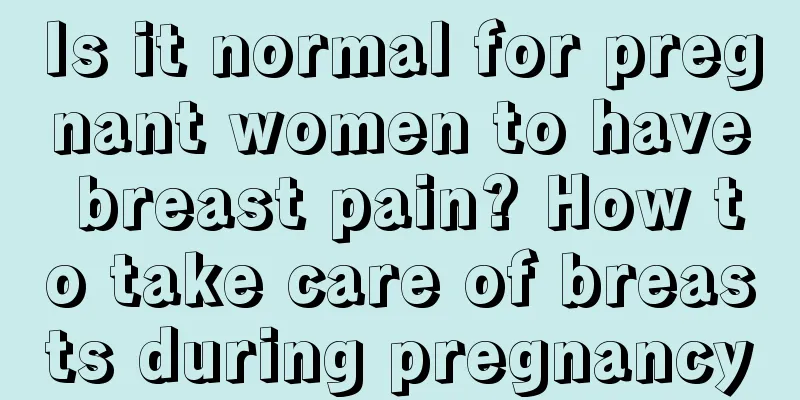Is it normal for pregnant women to have breast pain? How to take care of breasts during pregnancy

|
Breast pain in pregnant women is a very common phenomenon. Many pregnant women experience breast pain during pregnancy. It is very important for women to take care of their breasts during pregnancy. Mild breast pain is a normal physiological phenomenon. Is breast tenderness normal during pregnancy?Breast pain is a common phenomenon in pregnant women. Generally, about 40 days after pregnancy, the placenta and villi secrete a large amount of estrogen and progesterone, which enlarges the breasts and causes breast pain. In severe cases, it can last throughout the pregnancy. This physiological pain is normal and usually does not require treatment. However, if it is pathological breast pain, you should seek medical treatment in time. The most common causes of pathological breast pain are breast hyperplasia and mastitis, so don't delay it. How to care for breasts during pregnancy1. How to maintain breasts before pregnancy: When sperm and egg combine to form a fertilized egg and begin to grow in the uterus, estrogen and progesterone will increase significantly. For breasts, all changes begin. The production and delivery of milk tissues immediately develop vigorously. You won't feel anything obvious at first, but the changes in your body will soon make you aware of them. Many expectant mothers will feel heavy, painful, and tight breasts, which is the first sign of pregnancy. Some people feel like breast pain before menstruation, but it is more severe. Tips: There is nothing special to do at this time, just test whether you are pregnant. Cold compresses may help you relieve breast pain and tension. 2. How to take care of breasts during early pregnancy: The nipples will become firmer and more sensitive, the areola will gradually expand and darken in color. The small papules surrounding the areola (these areola glands, also called Montgomery glands, are responsible for secreting an oily antibacterial substance that cleanses, lubricates and protects the nipples) will become more prominent. The entire breast will swell and the texture of the surface skin will become more obvious. The tightness, heaviness and fullness of the breast will still be more obvious. Suggestion: It is time to buy yourself two bras of a larger size. During the entire pregnancy, the breasts on both sides will gain about 900 grams respectively. A bra with the right cup size can help you protect the health of your breasts. It is important to note that you should never buy a bra that is too small, otherwise it will restrict the normal development of breast tissue and affect future breastfeeding. Don't buy a larger size just for economic reasons, so that you can use it for future breast enlargement. An inappropriate bra will not be able to support the heavy breasts and protect the glands from growing comfortably. 3. How to take care of breasts during pregnancy: The color of the areola deepens and darkens, the areola glands become more prominent, the breasts continue to grow, and the texture of the epidermis becomes clearer. Due to the rising estrogen levels, the sensitivity of the nipples also increases. Due to the growth of the breasts, stretch marks may appear. Straw-colored colostrum may also seep out at this time, of course, it is more common to seep out later. Recommendation: Avoid using soap and excessive washing, which can be uncomfortable, dry, and is basically unnecessary (because the areolar glands will help you clean the nipples). You can then use warm water to lightly apply and clean the leaking milk, then gently stroke the nipples and let them dry naturally in the air. 4. How to take care of breasts during pregnancy: The enlargement of breasts and all changes in the appearance and feel of breasts will become more obvious in the late pregnancy. Even if the breasts of expectant mothers do not change very obviously in the early and mid-pregnancy, they will find obvious changes in their breasts during this period. Most people will have colostrum leakage. Suggestion: During this period, you should take good care of your nipples for breastfeeding. On the one hand, you should ensure that your nipples can be well held in the baby's mouth. If your nipples are inverted, you can do nipple trimming for yourself twice a day at noon and in the afternoon - use your thumb and index finger to gently press the breasts along the upper and lower directions on the areola to make the nipples protrude as much as possible. Be careful not to pinch the nipples with your thumb and index finger, as this will make them more inverted. 5. How to care for pregnant women's breasts after childbirth. Immediately after childbirth, mothers usually do not notice any changes in their breasts. Even when the baby starts sucking and eats colostrum, the mother's breasts will not feel anything special. But once the milk comes down after two or three days, the inside of the breasts will feel full of milk. When the baby sucks, the breasts will feel like milk is coming out, and they will feel numb and itchy. When there is too much milk, there will be a little swelling and pain. In addition, many mothers find that their breasts, which used to be very swollen and feel very big after childbirth, suddenly become very small and sag after weaning. Why is this? In fact, postpartum breasts become loose, sagging, atrophied, and the nipples and areolas become darker. These are all obvious manifestations of insufficient Qi and blood. Nutrition cannot reach the breasts, and the hormones secreted by the uterus and ovaries are insufficient. In addition, the meridians are blocked, the breast mammary glands are aging, and the breasts cannot absorb Qi and blood. The breasts will continue to expand outward, become loose, and sag. Suggestion: Letting the baby suckle as early as possible is the best way to stimulate milk production as soon as possible, and it can also avoid breast congestion. To ensure sufficient milk, the most important thing for mothers after childbirth is a good rest and diligent breastfeeding. Physiological breast pain in pregnant womenAccording to the physiological development characteristics of women, physiological breast pain mainly falls into the following categories: 1. Breast pain during puberty Girls aged 9 to 13 begin to develop breasts, and the breast tissue under the nipple will develop a pea- or bean-sized dome-shaped lump, which is slightly painful. After menarche, it will disappear on its own as the breasts mature during puberty. 2. Breast pain during menstruation It is the most common type of breast pain, accounting for about 65% of all breast pain, with an average age of 35 years. The pain often occurs or worsens about 3 to 7 days before menstruation. The degree of pain is not consistent from month to month, and it is common to feel heaviness, distending pain, dull pain, or occasional short-term pins and needles. It is also accompanied by tender breast nodules, which are aggravated by compression, activity, or using objects. This is caused by increased estrogen levels in the body before menstruation, breast hyperplasia, and edema of breast interstitial tissue, and gradually disappears or alleviates after menstruation. 3. Breast pain during pregnancy Some expectant mothers experience breast pain around 40 days after pregnancy due to the placenta and villi secreting large amounts of estrogen and progesterone, which enlarges the breasts. In severe cases, it can last throughout the pregnancy and usually does not require treatment. 4. Postpartum breast pain Breast fullness, hardness and pain often occur 3-7 days after delivery, which is mainly caused by the effect of prolactin, venous filling, interstitial edema and milk filling. Therefore, mothers should breastfeed as soon as possible. If there is a hardness, they can apply hot compress and massage the hardness before breastfeeding, or use a breast pump to suck milk to promote the patency of the mammary duct. 5. Breast pain after artificial abortion Some women feel breast pain and lumps after miscarriage. This is because the pregnancy is suddenly interrupted, the hormone level in the body drops sharply, and the newly developed mammary glands suddenly stop growing, causing breast lumps and breast pain. 6. Breast pain after sex For those with low libido or an unharmonious sex life, the congestion and swelling of the breasts will not subside easily or will not subside completely due to lack of sexual satisfaction. Continuous congestion will cause breast pain. Therefore, women should pay attention to a good sex life, and those who have no orgasm or low libido should seek medical attention. 7. Mental and emotional influences lead to breast pain In addition, breast pain is often related to the mind, which is affected by mood swings and work stress. Because the mind can affect hormone secretion and menstruation, leading to breast hyperplasia and other conditions. Usually when you are too busy at work and the pressure is increased, not only will you have menstrual disorders, but you will also have breast pain. Pathological breast pain in pregnant women1. Breast hyperplasia and breast pain It does not change with the menstrual cycle, has no fixed time, and lasts longer. These women are mostly around 40 to 45 years old, slightly older than those with physiological pain. The pain is limited to the breast and is relatively shallow. 2. Mastitis and breast pain This pain is very obvious and unbearable, and is accompanied by redness, swelling and heat. It mostly occurs in primiparas within 1 to 2 months after delivery. |
<<: What is the best gift for a woman who has just given birth?
>>: How to improve your baby's picky eating How to deal with your baby's picky eating
Recommend
What to do if your child is anxious when he or she just starts kindergarten
Baby learning needs to start from kindergarten, a...
Is a baby who can't crawl not smart? Is a baby who can't crawl a sign of stupidity?
Usually, learning to crawl is the first step for ...
What causes urinary tract infection in babies? What causes repeated urinary tract infection in babies?
Urinary tract infection is a hidden disease. If a...
What are the causes of headaches in children? The most common one is actually the third one
Headache is a common phenomenon, and many people ...
What is the difference between Vinda's cored and coreless toilet paper rolls? Which one is more cost-effective to buy from Vinda?
Vinda tissues come in two types: cored and corele...
Which is better, a pregnancy test stick or a pregnancy test paper? Which is more accurate, a pregnancy test stick or a pregnancy test paper?
Pregnancy test sticks and pregnancy test strips a...
Can I eat green oranges while breastfeeding? Can I eat oranges while breastfeeding?
Oranges are a popular fruit in autumn, and many p...
At what age should breastfed babies start to eat complementary foods? Introduction to the time to add complementary foods to breastfed babies
How many months does it take for breastfed babies...
What are the symptoms or feelings on the ovulation day?
When it comes to ovulation period, everyone shoul...
How long can I take a shower after a cesarean section? How to protect the wound after taking a shower after a cesarean section?
After a caesarean section, women are weaker and n...
How to treat retinopathy of prematurity and what causes it
Good vision is the key to a baby's growth. Pa...
How to prepare the dipping sauce for boiled shrimp How to make boiled shrimp for babies
Boiled shrimp is a kind of shrimp cooked in boili...
Why does the baby sleep with his mouth open? How to correct the baby sleeping with his mouth open?
It's cute for babies to sleep with their mout...
Can a flatulence patch be used on a newborn baby with flatulence? What kind of navel patch can be used on a newborn baby with flatulence?
Newborn bloating is a common phenomenon, mostly c...
What embarrassing things will happen when having a child? Will having a child make you older?
Giving birth is the most painful and embarrassing...









